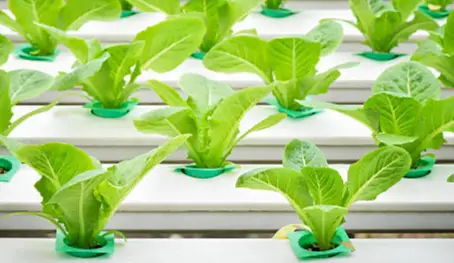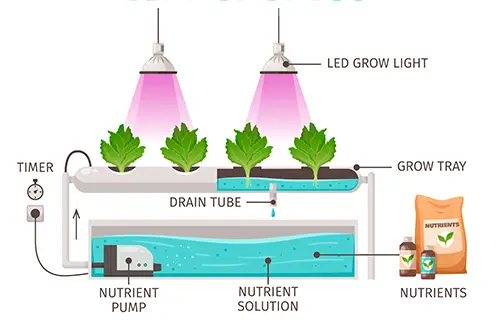Helpful Guides on each Category
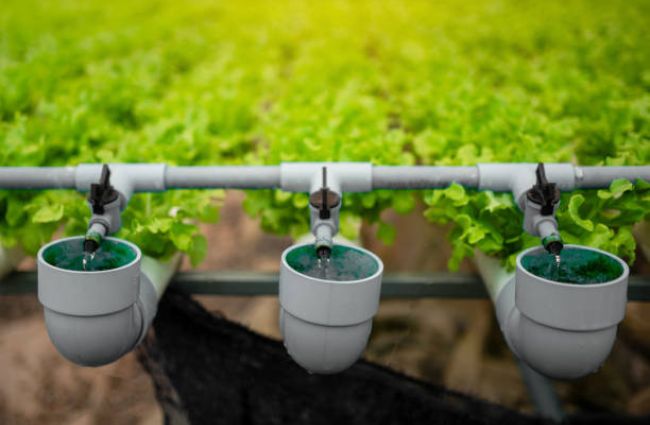
Ever wanted vegetables all year round? You can achieve that by growing hydroponic vegetables. Hydroponics is a cool way to cultivate plants without the mess of dirt. If you’re curious about the best vegetables to grow hydroponically (yeah, that means without soil), you’re in for a treat. Let’s see the best hydroponic vegetables to cultivate and harvest huge yields quickly.
hydroponics makes growing veggies more sustainable, especially if you’re short on space. No need for a huge backyard; you can do it right on your balcony or windowsill. Perfect for city folks or anyone with a nice space at home.
And get this – with hydroponics, you’re not stuck waiting for the right season. It’s like having a forever garden! Snow, rain, or shine, your veggies keep growing.
Is it Good or Bad to Grow Vegetables Hydroponically?
Pros of hydroponic vegetables
- When properly managed, hydroponically grown vegetables can be just as nutritious as traditionally grown ones. Some argue they are nutritionally superior due to controlled nutrient delivery.
- Hydroponics allows for optimal control over the environment and nutrition, often leading to higher yields and better quality produce. The vegetables tend to be juicier, crisper, and with potentially enhanced flavour.
- You can cultivate fresh vegetables any time of year with hydroponics, as you’re not reliant on weather conditions.
- Hydroponics uses significantly less water and land than traditional farming, making it a more sustainable option. Additionally, it reduces the need for pesticides and herbicides.
- Hydroponic systems can be set up anywhere, regardless of soil quality or climate, making it ideal for urban environments or those with limited space. They’re also generally low-maintenance.
Cons of hydroponic vegetables
- Setting up a hydroponic system is more expensive than traditional gardening, especially for larger setups.
- Maintaining a hydroponic system requires technical knowledge and understanding of plant needs and nutrient formulas.
- While generally more sustainable than traditional farming, some hydroponic systems use non-renewable materials or energy sources, raising environmental concerns.
- Some people argue that hydroponically grown vegetables lack the earthy taste and texture of soil-grown produce.
- Although less likely than soil-grown vegetables, hydroponic systems can still be susceptible to contamination if not properly maintained.
List of Best Vegetables to Grow hydroponically
Below is a quick list of best hydroponic vegetables;
- Lettuce
- Spinach
- Kale
- Arugula
- Swiss Chard
- Basil
- Mint
- Cilantro
- Oregano
- Thyme
- Tomatoes
- Peppers
- Cucumber
- Eggplant
- Beans
- Chives
- Zucchini
- Collard Greens
- Bok Choy
- Beet
- Radish
- Celery
- Broccoli
1. Lettuce
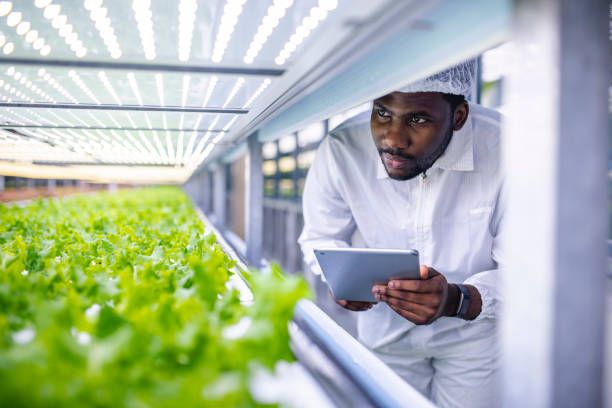
Lettuce is one of the best vegetables to grow hydroponically because it’s uncomplicated. With the right nutrients, water, and a bit of light, you’ll see your lettuce thrive without the hassle of soil. This simplicity makes it an excellent choice for beginners and those looking for a low-maintenance hydroponic journey.
One of the most impressive perks of hydroponic lettuce is its speed. Without soil limitations, lettuce can grow up to 50% faster in a hydroponic system. You’ll be harvesting fresh, crisp leaves in no time, adding a burst of flavour to your salads and sandwiches.
Lettuce comes in various shapes, colours, and flavours, and hydroponics welcomes them all. Here are three lettuce varieties that thrive best in hydroponic setups:
- Romaine Lettuce: Known for its crunchy texture and elongated leaves, romaine lettuce is a hydroponic favourite. It’s perfect for Caesar salads and wraps.
- Butterhead Lettuce: With its tender, buttery leaves, this variety is a hydroponic delight. It forms loose heads and adds a mild, sweet flavour to your dishes.
- Leaf Lettuce: This variety includes red and green leaf lettuce. It’s easy to grow hydroponically and offers a mix of textures and flavours, making it a versatile addition to your hydroponic garden.
2. Spinach
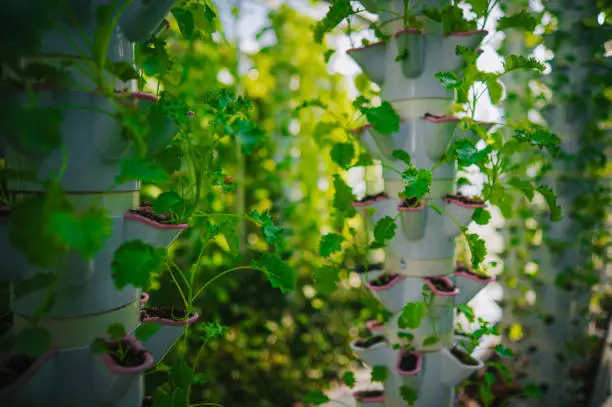
Spinach is renowned for its exceptional nutritional content. It’s a rich source of vitamins A, C, and K, along with essential minerals like iron, calcium, and magnesium. Growing spinach hydroponically allows for precise control over nutrient levels, ensuring that your spinach leaves are not only delicious but also bursting with health benefits.
Creating the ideal environment for hydroponic spinach involves understanding its preferences:
- Temperature: Spinach thrives in cooler temperatures. Aim for a daytime range of 50-75°F (10-24°C) and a slightly lower temperature at night.
- Light: While spinach can tolerate partial shade, it generally benefits from at least 10-12 hours of light per day. If you’re growing hydroponically indoors, consider providing fluorescent or LED lights to mimic sunlight.
- pH Levels: Maintain a slightly acidic to neutral pH range between 6.0 and 7.0 in your hydroponic system for optimal nutrient absorption.
- Nutrient Solution: Spinach prefers a balanced nutrient solution, with slightly higher nitrogen levels for robust leafy growth. Regularly monitor and adjust nutrient concentrations to meet the plant’s changing needs throughout its growth stages.
- Watering: Hydroponic systems provide a consistent water supply, avoiding the risk of overwatering or underwatering. Ensure proper water circulation to prevent stagnant conditions.
3. Kale
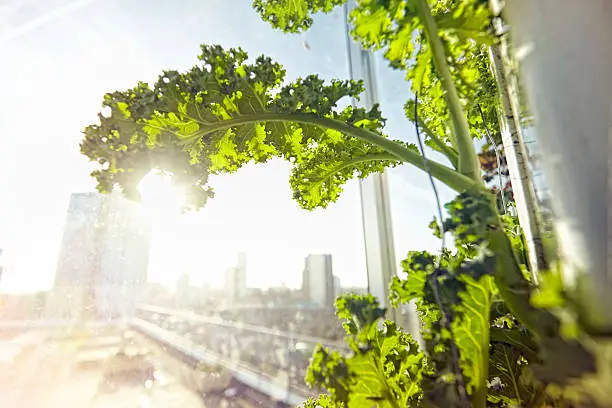
When it comes to robust flavour and an abundance of health benefits, hydroponic kale stands tall. From salads to smoothies, this leafy green powerhouse is not only versatile in the kitchen but also a nutritional champion.
Kale is a nutrient-dense green that adds a bold flavour and vibrant colour to your meals. Packed with vitamins A, K, and C, as well as minerals like iron and calcium, kale is a nutritional juggernaut. Growing kale hydroponically ensures that it receives the precise balance of nutrients, contributing to its exceptional health benefits. Whether you’re aiming for a crisp salad or a nutrient-packed smoothie, hydroponic kale is your go-to green for both taste and health.
Here’s how to make the most of your hydroponic kale harvest:
- Harvest kale leaves when they reach a desirable size, typically around 8-10 inches in length. Use clean scissors or shears to snip the outer leaves, allowing the inner leaves to continue growing. This encourages a continuous harvest.
- To keep your hydroponic kale fresh, store it in the refrigerator. Place the leaves in a plastic bag with a slightly damp paper towel to maintain humidity. Properly stored, hydroponic kale can stay fresh for up to two weeks.
- Regularly harvest outer leaves to encourage new growth from the centre of the plant. This “cut and come again” method allows for a sustained harvest throughout the growing season.
- Bolting, or premature flowering, can affect the taste and texture of kale. Maintain consistent temperatures and avoid sudden temperature fluctuations to prevent this.
4. Arugula
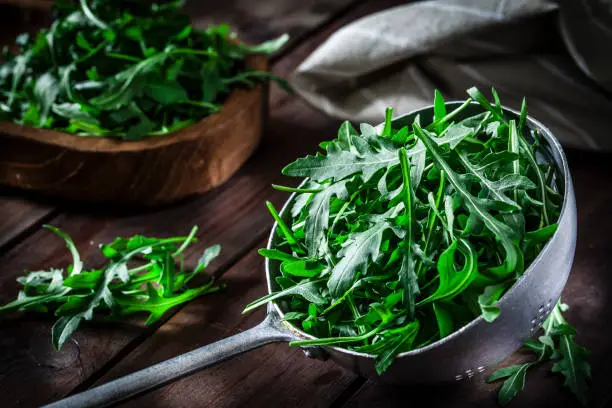
This vegetable that can be grown hydroponically adds a zesty twist to your salads and dishes. Known for its distinctive peppery flavour, hydroponic arugula is not just a taste sensation but also a speedy grower, making it a delightful addition to your home garden.
Arugula’s bold, peppery taste sets it apart in the world of leafy greens. The hydroponic environment allows for precise control of nutrient levels, enhancing the distinctive flavour that makes arugula a favourite among food enthusiasts. Its vibrant leaves add a punch to salads, sandwiches, and even pizzas, giving your culinary creations a flavorful kick.
One good thing about growing arugula hydroponically is its impressive speed of growth. In a soilless system, arugula has the advantage of accessing nutrients directly, leading to quicker development. You’ll be delighted to harvest fresh, tender arugula leaves in a matter of weeks, providing a continuous supply for your kitchen.
5. Swiss Chard
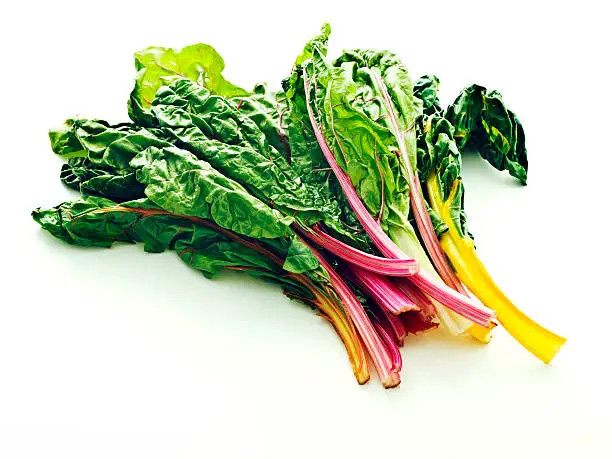
Hydroponic Swiss chard is a delightful addition to any home garden.
Swiss chard is a feast for the eyes, boasting a palette of vibrant colours that include shades of red, pink, yellow, and green. This visual diversity makes it not only a favourite among gardeners but also a stunning addition to salads, stir-fries, and sautés.
Growing Swiss chard hydroponically brings out its colour very well, offering a kaleidoscope of beauty for your home garden.
Swiss chard needs 12-16 hours of light per day. If growing hydroponically indoors, ensure proper lighting to mimic natural sunlight conditions.
When choosing Swiss chard varieties for hydroponics, consider these popular cultivars that thrive in a soilless environment:
- Bright Lights: This variety is a colourful standout, featuring stems in shades of red, orange, pink, yellow, and white. Each stem is a visual treat, and the plant’s versatility makes it a joy to grow hydroponically.
- Fordhook Giant: Recognized for its broad, dark green leaves and white stems, Fordhook Giant is a classic Swiss chard variety. It adapts well to hydroponic systems, providing a steady supply of hearty leaves.
- Rainbow Chard: As the name suggests, Rainbow Chard showcases a spectrum of stem colours. This variety is not only visually appealing but also a versatile choice for hydroponic cultivation.
6. Basil
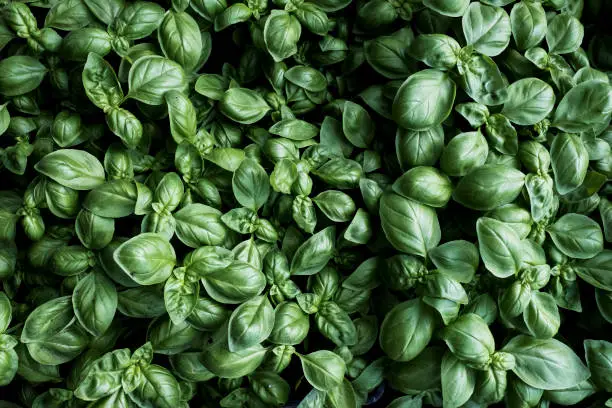
This aromatic herb isn’t just a kitchen staple; it’s a flavorful journey into the heart of hydroponic gardening.
Basil’s robust flavour, a delightful blend of sweetness and peppery undertones, makes it an irreplaceable herb in many cuisines. Whether in pasta sauces, salads, or as the star of fresh pesto, hydroponic basil offers an intense taste that elevates dishes to culinary excellence.
To keep your hydroponic basil thriving and flavorful, consider these tips for pruning and harvesting:
- Regularly pinch off the uppermost leaves of your basil plant to encourage bushier growth. This simple act not only prevents the plant from becoming too leggy but also promotes the development of more flavorful leaves.
- Harvest leaves when the plant has developed a few sets of true leaves. Be sure not to take more than one-third of the plant at a time, allowing it to continue growing and producing fresh leaves.
7. Mint
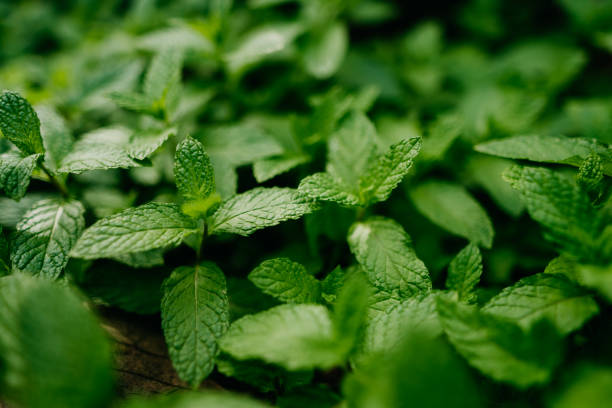
Mint’s invigorating flavour, with its hints of sweetness and coolness, makes it a popular choice for a wide range of culinary and beverage creations. From minty teas and refreshing mojitos to salads and desserts, hydroponic mint brings freshness to your table.
For me, of all the spice vegetables to grow hydroponically, I won’t miss out on this one.
These mints are best for your vegetable hydroponic garden:
- Peppermint: Known for its bold and intense flavour, peppermint adds a robust and cooling element to your dishes and drinks.
- Spearmint: With a milder taste compared to peppermint, spearmint is versatile and widely used in both sweet and savoury recipes.
- Chocolate Mint: This delightful variety has a hint of chocolate in its flavour, making it a unique and aromatic addition to desserts and beverages.
Mint thrives in bright, indirect light. If growing hydroponically indoors, provide at least 12-16 hours of light per day using fluorescent or LED lights. It prefers cooler temperatures, ideally between 60-70°F (15-21°C). Adequate airflow is essential to prevent issues like powdery mildew.
Regularly prune your mint to encourage bushy growth and prevent legginess. Pinch off the tips to promote lateral branching and a fuller plant.
8. Cilantro
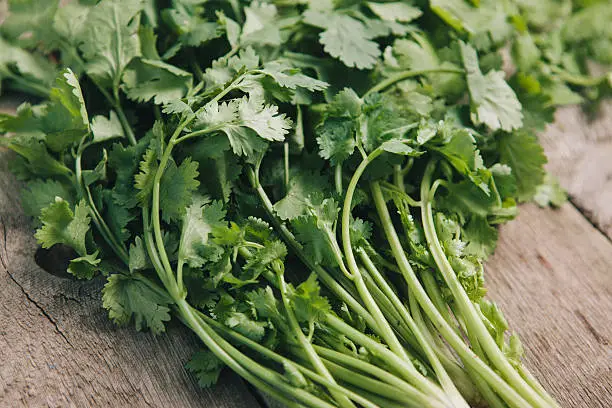
Cilantro, with its distinctive citrusy and herbaceous notes, adds a burst of freshness to a myriad of dishes. This herb is a cornerstone in Latin American and Asian culinary traditions, enhancing salsas, curries, and street foods. Hydroponically grown cilantro intensifies its flavours, offering a consistent and vibrant addition to your kitchen.
Cilantro has a tendency to bolt (produce flowers and seeds) prematurely, affecting its flavour and lifespan. Here are tips to prevent bolting in hydroponic cilantro:
Cilantro prefers cooler temperatures. Maintain a consistent environment, avoiding sudden temperature spikes that may trigger bolting. Aim for temperatures between 50-85°F (10-29°C).
Harvesting frequently, especially when the plant reaches about 6 inches height, helps delay bolting. Regular harvesting encourages leaf production and discourages the formation of flowers.
9. Oregano
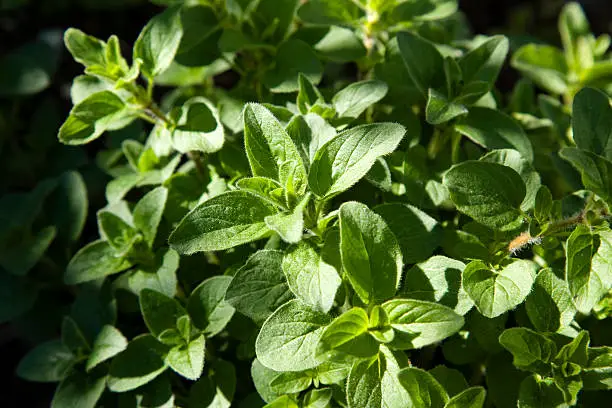
Oregano, with its high flavour, is a key ingredient in Mediterranean cooking. From pizzas and pasta to roasted vegetables, hydroponic oregano adds an aromatic punch that elevates dishes to a whole new level. Its versatility makes it a must-have in any herb garden, especially when cultivated using hydroponic methods.
For a thriving hydroponic oregano garden, Provide at least 12-16 hours of light per day using fluorescent or LED lights if growing hydroponically indoors. Ensure the light is evenly distributed to all parts of the plant.
Oregano prefers temperatures between 70-75°F (21-24°C) during the day and slightly cooler temperatures at night. Adequate airflow is essential to prevent issues like powdery mildew.
Maintain a balanced nutrient solution with a focus on phosphorus and potassium for robust flowering and flavour development. Regularly monitor and adjust nutrient levels to meet the plant’s needs.
10. Thyme
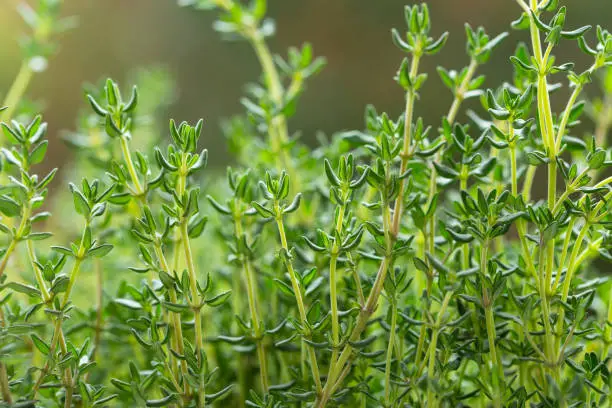
Hydroponic thyme, with its earthy and slightly minty flavour, is now in most kitchens. This herb is a staple in various cuisines, enhancing dishes from roasted meats and soups to vegetables and sauces. Hydroponic cultivation intensifies thyme’s flavour, offering a consistent and aromatic addition to your gastronomic adventures.
Snip the stems of thyme just above a set of leaves using clean scissors or pruning shears when growing hydroponically. Harvest in the morning when the essential oils are at their peak for maximum flavour.
Thyme is ideal for air drying. Bundle several stems together and hang them upside down in a well-ventilated area. Once dry, strip the leaves from the stems and store them in an airtight container. Alternatively, use a dehydrator for a quicker drying process. Is it strange that some Chefs nowadays prefer hydroponic Thyme?
11. Tomatoes
One of the best fruit vegetables to grow hydroponically. Under optimal conditions, hydroponically grown tomatoes often mature faster than their soil-planted ones, allowing for quicker harvests.
Hydroponic gardening opens doors to a multitude of tomato types suitable for various tastes and preferences. Cherry Tomatoes, Roma Tomatoes and Beefsteak Tomatoes are the best varieties of tomatoes to plant hydroponically.
To maximize the yield and health of your hydroponic tomatoes, use stakes or trellises to provide support as the plants grow, and remove suckers (side shoots) to direct energy toward fruit production. Prune excessive foliage to improve air circulation and reduce the risk of diseases.
12. Peppers (bell peppers, chilli peppers)
From the sweet and mild tones of bell peppers in red, yellow, and green to the fiery heat of chilli peppers in various shades, planting peppers hydroponically increases the colours and spice.
When planting your hydroponic peppers, in the absence of natural pollinators, gently shake the plants or use a small brush to transfer pollen between flowers. This helps ensure proper fruit development.
Introduce beneficial insects like ladybugs or predatory mites to control pests such as aphids or spider mites. These natural allies can help maintain a healthy hydroponic pepper garden.
13. Cucumbers
Probably the easiest and fastest veggies to grow hydroponically, cucumbers are renowned for their rapid growth.
When growing cucumbers hydroponically, it is best to train the vines vertically using trellises or other support structures. This saves space and encourages better air circulation and sunlight exposure for healthier plants. Use slings or mesh bags to support growing cucumbers. This prevents the fruit from placing undue stress on the vines and promotes straighter, more uniform growth.
Regularly prune side shoots and excess foliage to channel energy into fruit production. This practice helps prevent overcrowding and improves the overall health of the plant.
For a thriving hydroponic cucumber garden, ensure these optimal growing conditions:
- Temperature: Cucumbers thrive in warmer temperatures, ideally between 70-75°F (21-24°C) during the day and slightly cooler at night.
- Lighting: Provide at least 12-16 hours of light per day using fluorescent or LED lights if growing hydroponically indoors. Cucumbers benefit from consistent and evenly distributed light.
- Nutrient Solution: Maintain a balanced nutrient solution with a focus on potassium and phosphorus for robust flowering and fruiting.
14. Eggplant
Similar to peppers, gently shake the plants or use a small brush to transfer pollen between flowers. This helps ensure proper fruit development, especially in the absence of natural pollinators.
Consider planting companion herbs or flowers that deter pests, such as basil or marigolds, around your hydroponic eggplants. This natural approach can help prevent common pests and promote a healthy garden.
Implement IPM strategies, including regularly inspecting plants for signs of pests and intervening with organic solutions when necessary. This proactive approach can minimize the impact of pests on your hydroponic eggplants.
15. Beans
As every green thumb knows, this will pass as one of the best vegetables to grow hydroponically. Two primary categories of beans are widely grown in home hydroponic gardens
- Bush Beans: Compact and ideal for smaller spaces, bush beans are well-suited for hydroponic systems. They grow in a bushy form and don’t require additional support.
- Pole Beans: Perfect for vertical gardening, pole beans climb on trellises or supports. Hydroponic pole beans thrive with proper training and support.
Provide a vertical support structure, such as trellises or stakes, for pole beans to climb. This not only saves space but also encourages efficient growth and easier harvesting.
Gently guide pole bean vines onto the support structure to encourage upward growth. This aids in better exposure to light and air circulation, promoting healthier plants.
16. Chives
Chives, with their mild onion flavour and slender green shoots, are very useful in any hydroponic herb garden. Used as a fresh garnish or added to salads, soups, and dips, hydroponic chives bring a touch of elegance and a burst of flavour to your culinary creations.
Chives thrive in bright, indirect light. If growing hydroponically indoors, provide at least 12-16 hours of light per day using fluorescent or LED lights.
Maintain a cool environment for chives, ideally between 60-70°F (15-21°C).
17. Zucchini
This summer vegetable is one of the vegetables to grow hydroponically with the highest yield. Hydroponic gardening offers several advantages, such as efficient nutrient uptake, a controlled environment, and faster growth rates.
Choose a hydroponic system that suits your space and preferences. Nutrient Film Technique (NFT), Deep Water Culture (DWC), and Dutch Bucket systems are mostly used for growing vegetables like zucchini.
Use a balanced hydroponic nutrient solution specifically formulated for fruiting vegetables.
Maintain the pH level of the nutrient solution within the optimal range for zucchini, which is typically between 5.8 and 6.5. This ensures that nutrients are readily available for uptake.
These plants prefer warm temperatures. Maintain the ambient temperature between 70°F to 85°F (21°C to 29°C) during the day and slightly cooler at night. Keep humidity levels around 60-70%.
Provide sufficient light for the zucchini plants. If growing indoors, use high-quality grow lights with the appropriate spectrum for the vegetative and flowering stages. Zucchini plants require at least 6-8 hours of direct sunlight or its equivalent in artificial light.
Zucchini plants require pollination for fruit development. In a hydroponic system, you may need to manually pollinate the flowers using a small brush to transfer pollen between male and female flowers.
Since they produce large and heavy fruits, provide adequate support, such as trellises or cages, to prevent the plants from collapsing under the weight of the fruit.
18. collard greens
Collard greens are one of the most nutritious vegetables to grow hydroponically, and they flourish in hydroponic systems. This is one of the most sought after vegetables to grow hydroponically as they are popular in many recipes.
Collard greens thrive in bright, indirect light. If growing hydroponically indoors, provide at least 12-16 hours of light per day using fluorescent or LED lights.
Maintain a balanced nutrient solution with a focus on nitrogen for lush, leafy growth. Regularly monitor and adjust nutrient levels to meet the plant’s needs.
These vegetables prefer cooler temperatures, ideally between 60-70°F (15-21°C). Adequate airflow helps prevent issues like powdery mildew.
19. bok choy
Bok choy, with its white stems and dark green leaves, adds a refreshing crunch and mild flavour to a variety of dishes. Hydroponically grown bok choy maintains its crisp texture and delicate taste, providing a continuous supply of these elegant leafy greens for your culinary adventures.
Bok choy thrives in bright, indirect light. If growing hydroponically indoors, provide at least 12-16 hours of light per day using fluorescent or LED lights. They prefer cooler temperatures, ideally between 50-75°F (10-24°C).
20. Beet
Hydroponic beets, with their brilliant colours and earthy sweetness, add that early morning visual and flavorful appeal to your garden. These root vegetables are not only tasty but also very rich in vitamins, minerals, and antioxidants.
Beets thrive in bright, indirect light. If growing hydroponically indoors, provide at least 12-16 hours of light per day using fluorescent or LED lights. They prefer cooler temperatures, ideally between 50-75°F (10-24°C). Adequate airflow helps maintain optimal conditions for healthy growth.
21. Radish
Growing Radishes hydroponically makes their vibrant reds, purples, and whites stand out as they get maximum growth requirements. These crisp and peppery root vegetables are a quick and easy addition to salads, sandwiches, and snacks.
If growing hydroponically indoors, provide at least 12-16 hours of light per day using fluorescent or LED lights. Maintain temperatures, ideally between 50-70°F (10-21°C).
22. Celery
For successful hydroponic celery cultivation, maintaining specific conditions is crucial. Celery thrives best when the pH level of the nutrient solution falls within the range of 5.8 to 6.5. Additionally, keep the temperature between 60°F to 70°F (15°C to 21°C) to ensure optimal growth.
A key consideration is the nutrient solution’s composition. Celery requires a balanced mix of essential nutrients, including nitrogen, potassium, and phosphorus. Regular monitoring and adjustment of nutrient levels are essential for healthy celery plants. Lastly, ensure that the hydroponic system provides adequate support for the relatively tall and upright nature of celery.
23. Broccoli
Creating the best hydroponic conditions for broccoli involves careful attention to several factors. Start by maintaining a pH level between 6.0 to 6.7 in the nutrient solution. Broccoli plants also prefer a slightly cooler environment, with temperatures ranging from 50°F to 70°F (10°C to 21°C).
Nutrient concentration is critical for broccoli’s success in hydroponics. Ensure a well-balanced mix, with a focus on providing sufficient calcium to prevent disorders such as tip burn. Adequate spacing between plants in the hydroponic system allows for proper air circulation and light penetration, promoting healthy broccoli development.

